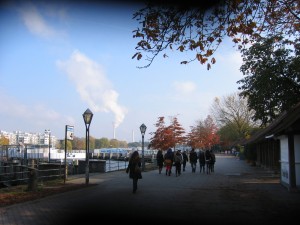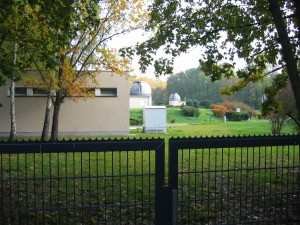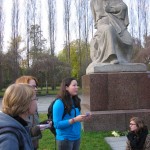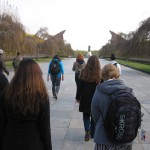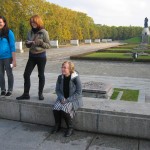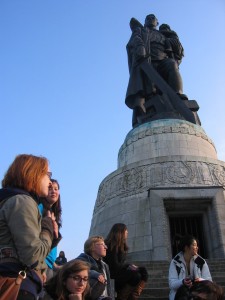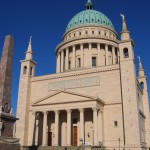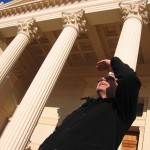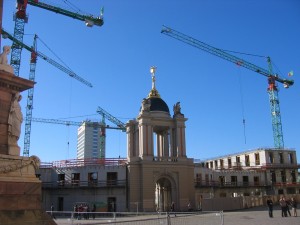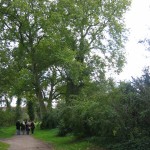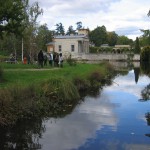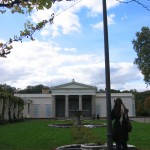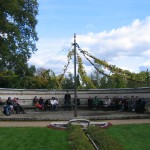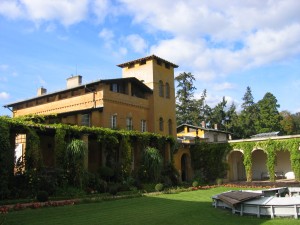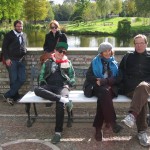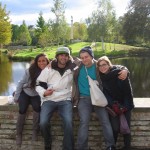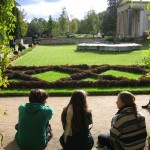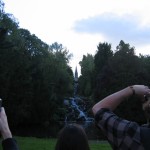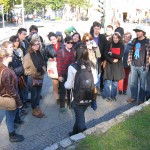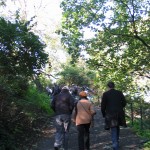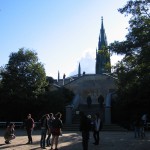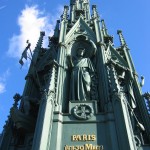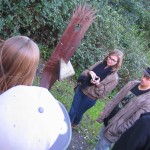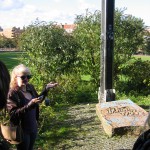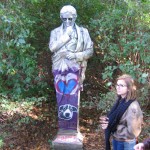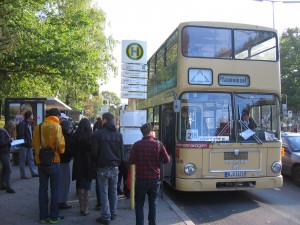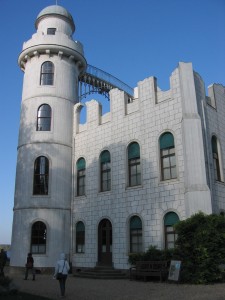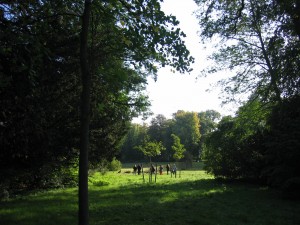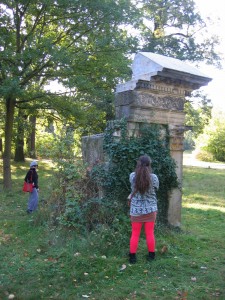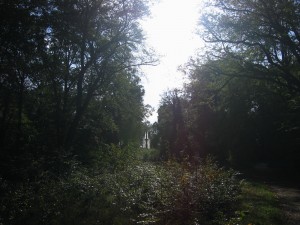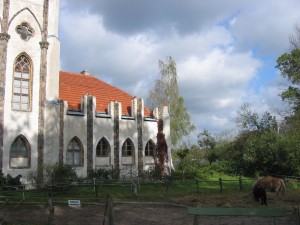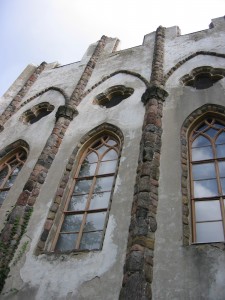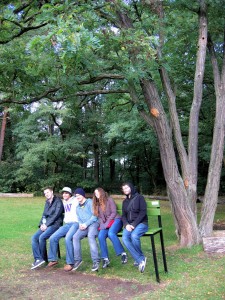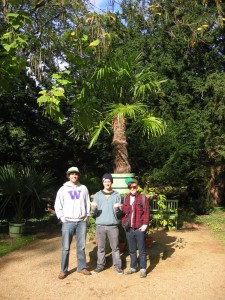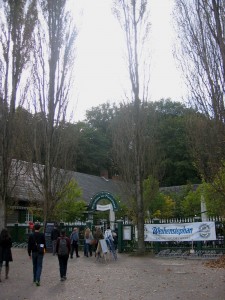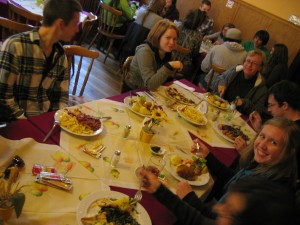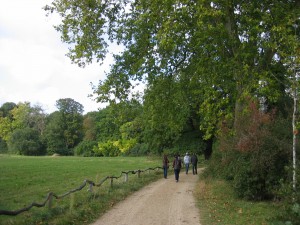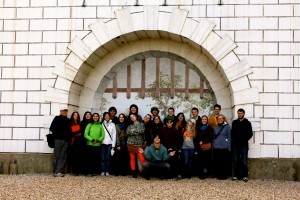Treptower Park with Anna, Mariah and Janet
The student tour this week brought us to Treptower Park, home to …
… houseboats (one of three colonies in Berlin) …
An observatory built for a world’s expo in the park around the turn of the century, and later supposedly used by Einstein …
… and an absolutely massive Soviet World War II memorial and cemetery. Since the park lies in what was formerly East Berlin, it was a natural choice for the Soviets to honor 7,000 of their men who died here. The site is now under the official protection and care of the German government, thanks to a line in the treaty signed by the Soviets in 1989.
The main attraction is a 38-foot statue of a Soviet solder saving a child, posed over a broken swastika. Though it’s a bit over the top, one can’t help but think about the staggering number of men buried here. It’s another sobering facet of Berlin’s complex, and often tragic, history.
A day in Potsdam
Our day trip to Potsdam featured more of our favorite 19th-century designer, Karl Friedrich Schinkel. (You probably think we’re just obsessed with him, but believe us – he truly was great!) We began at the St. Nikolaikirche near the city center. It was begun according to plans by Schinkel, but finished by his student Ludwig Persius.
Berlin isn’t the only city that is rebuilding past monuments – here you can see that Potsdam is also busily rebuilding its royal palace (across from the Nikolaikirche), as a home for the state parliament. Meanwhile, East German buildings on the other side of the square are slated for demolition and replacement.
A trek across Potsdam and through Sanssouci park brought us to another Schinkel site, this one built for a very elite audience – the crown prince.
Schinkel built a tiny summer palace (really the size of a summer home) for the prince, who was a prolific artist and designer himself. Together, they fashioned what the prince referred to as “Siam” – a utopian space filled with rich symbolism, much of which is now lost on those of us without the proper classical education!
Schinkel also designed a house for the court gardener, which later became a billiards room, tea lounge and general garden leisure space for the prince and his friends.
We took some leisure time ourselves – to contemplate the connection between human constructive activity and that of nature, as Schinkel intended – before heading off on our own walks through the rest of Sanssouci park. Next week: Berlin around the turn of the century!
Viktoriapark walk with Annie, Melissa and Rachel
Our students Annie, Melissa and Rachel took us on a tour of Viktoriapark this week. As they explained, the park is home to the “Kreuzberg” (literally “Cross Mountain”) and gives its name to the surrounding neighborhood. The “Kreuz” – really a monument to the wars of liberation against Napoleon – was designed by this week’s featured 19th-century starchitect, Karl Friedrich Schinkel.
It’s a bit of a climb …
… but it’s worth it! There are beautiful views of the city, and of course, a lovely gothic monument to admire as well.
Schinkel isn’t the only artist to have left his mark (whether officially sanctioned or not) on the park. Our guides showed us an artwork commemorating a recent act of sexual violence in the park, another in honor of the uprising of Communist workers in 1953, and one (a spray-paint-covered statue of Heinrich von Kleist) that attests to one of Berlin’s biggest vandalism issues – graffiti. As in the rest of Berlin, Viktoriapark is packed with history, and our tour guides did a lovely job of uncovering some of that for us.
A day on the Pfaueninsel
On Friday we took a trip about an hour outside of Berlin to a magical place called the Pfaueninsel – Peacock Island – for a class retreat. Our goal wasn’t to engage with official historical narratives so much as to relax and be together in a beautiful natural setting!
After riding the S-Bahn to Wannsee, we got to ride on a classic double-decker bus that took us through the woods to the entrance to the island.
Our first stop on the island was Schloss Pfaueninsel, erected for King Friedrich Wilhelm II and his mistress Wilhelmine Enke in the 1790s. Built from wood, it’s supposed to look like a white ruin on the island of Capri!
Of course, the first thing everyone looked for on the island were the eponymous peacocks – and the students found, and were chased aggressively by – a whole flock of them!
The island contains no end of sublime vistas and interesting architectural follies. It was formerly one of the many pleasure grounds of the Prussian royalty, replete with ridiculous attempts at the picturesque. For instance:
A “dairy” in the form of ruined Gothic church, where the king and his mistress could first play at milking the cows before going upstairs to drink milkshakes in an ornately decorated salon!
The island has some quirky modern works, too …
… and there are allusions to buildings that are no longer there, as well. A palm house designed by Karl Friedrich Schinkel once stood on this site, but it burned down in the late 19th century. A pleasant little palm garden pays homage to the absent building.
Though it was sunny, the weather was quite cold and windy. By lunchtime, we were thankful to sit down in the cozy Wirtshaus zur Pfaueninsel and enjoy some delicious home-style German food. Schnitzel, wild boar, Klopse (meatballs), Flammkuchen and pumpkin soup were all on the menu, accompanied, of course, by generous helpings of potatoes!
As we headed home, I couldn’t help thinking about the royals who had once frequented the island. What were their lives like? How would they have experienced the space? We’ll be finding out more about how they lived this coming week, when we visit Park Sanssouci, home to several royal Prussian palaces.
tags
the author
I'm a doctoral student at CUNY Graduate Center. I'm thrilled to be teaching the CHID Berlin program with Prof. John Toews! You can contact me at naraelle [at] gmail.com, or find out more about me at www.naraelle.net.
Blogroll
- Annie Holden's blog
- Cassie Hoeprich's blog
- Dominic Barrera's blog
- Janet Williams's blog
- Mariah Alderete's blog
- Melissa Au's blog
- Robert Hampton's blog
- UW Students Study Abroad Our students Natalie and Cassie are contributing to the official IPE student blog this fall!



